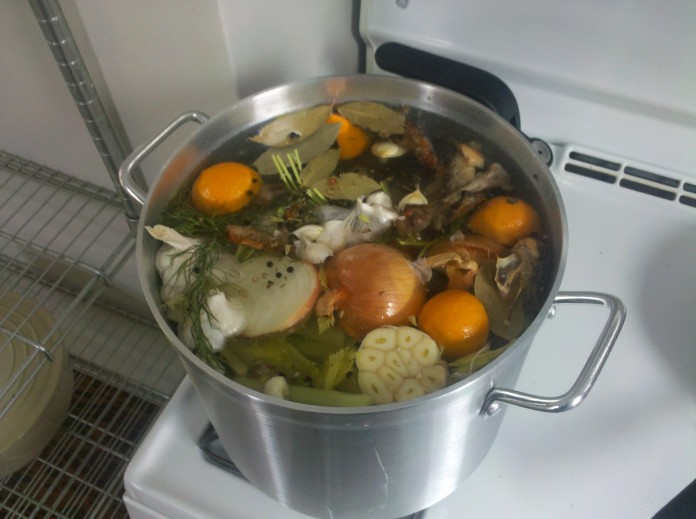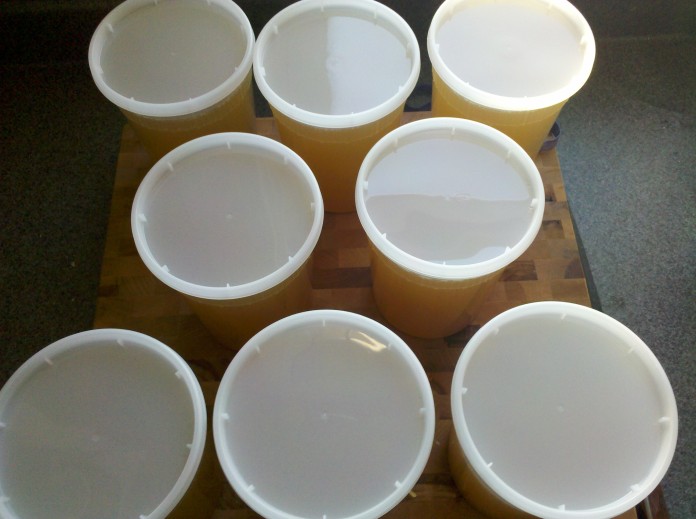I beg you.
Chicken, pork, beef, shrimp, clam, mushroom — whatever. It makes everything better.
Funny thing: I couldn’t tell you why I did it the first time. I think I was just curious. Now it’s one of those things I need to survive.
It doesn’t take much. A big-ass pot. An oven for roasting. A stove, preferably gas, but it doesn’t have to be. A water supply. Other stuff as needed.
Making stock is one of those things that tells me I’m home. Most stocks take a while to make, so you have to be comfortable in the space. It makes my place smell incredible. Sometimes for days.
Maybe most importantly, it slows me down. I can’t leave it totally unattended. Shower: yes. Grocery shopping: no. It’s the kind of thing you build a day around.
Making some chicken stock was a priority for me the minute I moved in to my new place. I use it a lot. In soups, in braises, in sauces, to cook rice, etc. It’s just something I always like to have around.
So I started with this:
Roasted bones from two chickens, carrots, celery, onion, halved heads of garlic, bay leaves, white and black peppercorns, cumin seeds, Meyer lemons, fresh dill and fennel fronds. I think that was everything.
You’ll notice: no salt. Part of the reason I make my own stocks is to manage the salt in the food I eat. Not because a doctor told me to, just because it tastes better that way. And besides, my salt tastes better than whatever industrial processing salt Swanson’s or whomever uses to package their cartons of stock.
Anyway.
Covered the whole thing with lots of water in the aforementioned big-ass uncovered pot and hit the heat.
Heat is the big trick here. Low enough it doesn’t boil, high enough the fat renders and rises to the top to skim off. A little bubbling is fine. It keeps the liquid moving and the solids suspended so they’re not just inert, sunk at the bottom.
And then, basically, you wait. Once it got up to temperature, I think I let it go five or six hours. Every 20 minutes or so, I’d check it, skim the fat, adjust the heat if I had to.
Shrimp stock is different. Take the shells, slice a lemon, add a bay leaf and peppercorns and boil it for half an hour or so, skim off the junk and you have something usable.
But with this, the whole time, it’s reducing, water floating off as vapor and concentrating the flavors in what’s left.
When it looks and tastes done, strain it well. Cheesecloth helps but is not mandatory. Sometimes putting one fine-mesh strainer inside another is all you need.
This being my first batch in this pot and in this kitchen, I spilled more than I would have liked. Still wound up with this yield:
And another view:
The containers are just quart containers I got for cheap here. Huge sack of like 30 of them and another of lids for I think $7 or $8 total.
What to do with all of it? Most of it heads to the freezer for when I need it. Some went to my friend Andrea, who had asked a while back on Twitter what homemade stock was good for.
My first meal with it: Beef braised in chicken stock with cauliflower and red bell peppers, smoked paprika, allspice, white pepper, cumin, roasted garlic, oregano and Sriracha.
The leftovers are even better.



